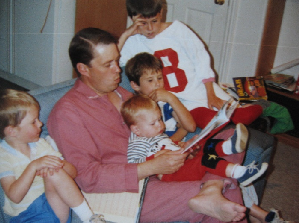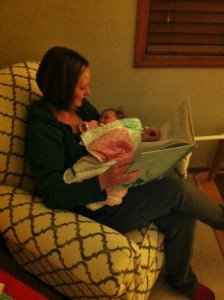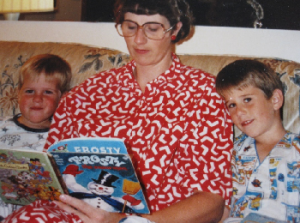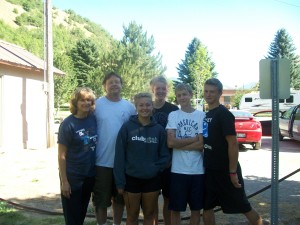 My husband and I have six children. Six!!! Who can believe it? This fact puts Dave (my husband) and I into the “experienced parents” category–especially since the youngest is now 23 years old. Parenting is not easy. Should I say that again?? Parenting is not easy. It’s not for wimps or the faint of heart. It takes commitment and effort and patience and effort and humor and effort and…….you get the idea.
My husband and I have six children. Six!!! Who can believe it? This fact puts Dave (my husband) and I into the “experienced parents” category–especially since the youngest is now 23 years old. Parenting is not easy. Should I say that again?? Parenting is not easy. It’s not for wimps or the faint of heart. It takes commitment and effort and patience and effort and humor and effort and…….you get the idea.
The other night, Dave and I decided to each compile a list of Ten Best Parenting Tips and then compare them. Turns out we had very similar lists, so we combined them and narrowed them down to our favorite ten. As some of you other parents might be looking for advice, we decided to share our list. Each week on Stance we will discuss one of the ten tips. So sit back, relax, and try to remember how excited you were to be a parent in the first place.
Read Aloud: Connecting with your Children
Read aloud to your children: From the time our children were born, we read aloud to them. When they were babies they just enjoyed being cuddled and hearing the rhythm of our voices. As they got older, they loved the sounds of words, especially rhyming and alliteration. To this day I can pretty much quote the entire story of The Cat in the Hat (Dr. Seuss). These rhyming books were not only fun, they were vital in helping our children learn how sounds go together, which in turn helped them learn to read. Beyond that, we found that simple books teach great principles. We have a son named Sam, so of course we read him Green Eggs and Ham (Dr. Seuss). Because of that book, we were able to encourage him to try new things. It’s fun to quote to our kids “You do not like it, so you say. Try it! Try it! And you may!” This phrase helped our kids with trying new foods, new clothes, and even making new friends. When we read Horton Hatches the Egg (Dr. Seuss) we were able to mosey into principles of responsibility and promise keeping.
When the kids reached elementary school age, they still loved being cuddled,  held, and sitting close, plus now they really enjoyed and understood the story line. Some of the first books we chose were Thornton Burgess’s books about the creatures of the forests and the meadows. In this series of books, the characters; Danny Meadow Mouse, Lightfoot the Deer, etc. are intertwined, with each book focusing on a different animal. (My oldest son, Kevin, loved them so much that for one of his birthdays, in his 20s, he asked for the complete set!) These books also taught important life lessons, like what it means to be a friend, the importance of preparation, and the wonderfulness of diversity. Charlotte’s Web (White) helped our kids learn to not judge others by their looks. Where the Red Fern Grows (Rawls) allowed us to talk about sorrow and death. Sometimes a book was so sad I had to hand it to my child to read because I couldn’t stop crying. We continued to read aloud even as the kids got older. Books that were exciting pulled them in. Hatchet (Paulsen), The True Confessions of Charlotte Doyle (Avi), and of course Harry Potter (Rowling) let us explore new geography, pirates, and wizardry as though we were having the experiences ourselves.
held, and sitting close, plus now they really enjoyed and understood the story line. Some of the first books we chose were Thornton Burgess’s books about the creatures of the forests and the meadows. In this series of books, the characters; Danny Meadow Mouse, Lightfoot the Deer, etc. are intertwined, with each book focusing on a different animal. (My oldest son, Kevin, loved them so much that for one of his birthdays, in his 20s, he asked for the complete set!) These books also taught important life lessons, like what it means to be a friend, the importance of preparation, and the wonderfulness of diversity. Charlotte’s Web (White) helped our kids learn to not judge others by their looks. Where the Red Fern Grows (Rawls) allowed us to talk about sorrow and death. Sometimes a book was so sad I had to hand it to my child to read because I couldn’t stop crying. We continued to read aloud even as the kids got older. Books that were exciting pulled them in. Hatchet (Paulsen), The True Confessions of Charlotte Doyle (Avi), and of course Harry Potter (Rowling) let us explore new geography, pirates, and wizardry as though we were having the experiences ourselves.
You might think that the only time to read is at bedtime. While we did read at bedtime almost daily, we found many other times to read. Taking a break from playing—or working—to relax and read was something I cherished as a young mother. Everyone needs a change of pace and I loved taking 15-20 minutes out of the day to read. Whenever we went on vacation we packed some books along. The kids liked to read their own book, but we also would choose two or three books to read aloud together.
 During the summer we joined the public library reading programs. Having prizes to earn motivated the kids to try new genres and broadened their world. We liked checking out books so much that I finally had to make a rule that each child could only check out as many books as they could physically carry. (Our record for checked out in one week was 54 books!!!) We sometimes read outdoors, sitting under a tree or on the patio. We would also read by the light of the Christmas tree, choosing one Christmas story each night before bed.
During the summer we joined the public library reading programs. Having prizes to earn motivated the kids to try new genres and broadened their world. We liked checking out books so much that I finally had to make a rule that each child could only check out as many books as they could physically carry. (Our record for checked out in one week was 54 books!!!) We sometimes read outdoors, sitting under a tree or on the patio. We would also read by the light of the Christmas tree, choosing one Christmas story each night before bed.
So why is reading to your children so important? Why did it make the parenting list for both my husband and me? There are three main reasons:
- Because reading aloud to a child can be a totally positive activity. You aren’t asking the child to perform or behave in any specific way. You are simply enjoying being entertained together, and can laugh or cry or react in any way you want and it’s ok. It’s a time to relax and be yourself and let the child be a child.
- It’s a way to enlarge a child’s world. How else can they discover what it feels like to experience war—Shades of Gray (Carolyn Reeder), try to coax a goose to fly—Chester, I Love You (Blaine M. Yorganson), or live alone on an island—Island of the Blue Dolphins (Scott O’Dell).
- It’s a way to teach values without preaching. (Tom Sawyer: “you can’t pray a lie.”)
Now that our kids are grown, do they still read? Yes, they do! I laughed when I found out that my son Stan has a public library card from every city he’s ever lived in. My kids like to recommend books to me and we enjoy discussing what we’ve read. So don’t hesitate—sit down and start reading. You don’t like it, so you say…try it, try it, and you may!
Written by Phyllis Rosen










